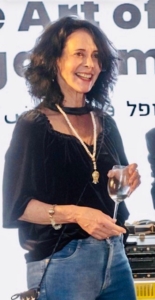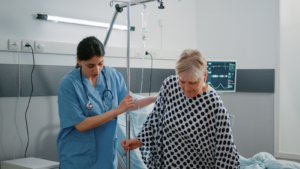Congress Newsletter 2022
ESAIC Honorary Member Award – Prof. Idit Matot
One of this year’s ESAIC Honorary Member Awards is our Scientific Programme Chair Prof. Idit Matot, who specialises in Geriatric Anaesthesiology at Tel Aviv Medical Center, Israel. Prof. Matot joins a long and distinguished list of Honorary Members, all of the esteemed colleagues who have dedicated their time and expertise to the activities of ESAIC and its predecessor organisations.
Q: Congratulations Idit on your Honorary Membership. Tell us how it feels to join this very special club
A: It is such a delight. Very exciting. And the feedback I receive from family, friends, colleagues, and people who call or comment in the media who I don’t even know – is amazing. I have to admit that the one thing I had in my mind when I got the message was that my mother, who is my friend and mentor, is not with me anymore… she would have been so proud. So… we party – my husband, 2 sons, 2 daughters-in-law and 5 grandchildren! We have 5 (grandchildren) under 5 so I can’t ask for more!
Q: For our members who don’t know you well, after completing your medical degree at the Hebrew University, Jerusalem, Israel, you spent a lot of time at the University of Pennsylvania, Philadelphia, USA. What made you want to do research in the US? Tell us about some of the studies you completed?
A: I actually was following my husband with our two small children for his paediatric neurology fellowship at the Children’s Hospital of University of Pennsylvania Hospital. I was interviewed there as well and fortunately got a position in the research unit of the anaesthesia department where I studied an animal model of pulmonary vascular activity. These years were the most critical years in my career because it gave me the tools, knowledge, and background to do experimental research. It was also an opportunity to establish friendships with many people from the clinical and scientific world, those who now “run the show” everywhere.
Q: You also spent time at the prestigious Stanford University in California – where you specialised in studies of the lung and liver. What kinds of things were you studying?
A: I had several aims while going on sabbatical to Stanford. One was to study liver regeneration, the other – clinical management of patients with pulmonary hypertension, but more so to follow my friend and a great chair of the department of anaesthesia and intensive care, Prof. Ron Pearl. During my 2 sabbaticals in Philadelphia (HUP) and in Stanford I went by myself leaving my family behind in Israel. It is not easy when you do this, but it gave me the time to make a lot of progress in my research.
Q: You have dedicated much of your career, especially the second half, to teaching and mentoring the next generation of anaesthesiologists. How different is it for young anaesthesiologists starting today compared to when you were starting out?
A: It’s a huge difference! In past years, learning was more passive. We mostly watched our seniors (see one, do one) and have had some departmental meetings. Nowadays, the educational activity is very programmed with daily early meetings with the residents (exams, case presentations, journal clubs etc), we teach by simulations – departmental and multidisciplinary, by personal mentoring, and we have courses (national) for preparing the resident for the written / oral Boards. So for those training today – lots of activity!
Q: We are all hoping we are now moving into the COVID ‘control’ phase, where we live with the virus instead of being dictated to by it. But it has also presented huge learning opportunities for how we organise critical care services and anaesthesiology. What are some of the positive things that have come out of the pandemic?
A: There are many opportunities that came along with the pandemic and I will list some: professional development, exposure to smart experts outside our field, numerous technological advancements that stemmed from industry/army/start-up groups/ entrepreneurs, telemedicine development, research, public support, and – very important – being proud of our profession!
Q: Of course, as Scientific Chair you designed our programme with other ESAIC colleagues. But which sessions will you be hoping to attend or at least watch again yourself?
A: The ones I won’t miss besides Sir Robert Macintosh and Prof. Ibsen lecture are the Research Lecture in memory of the late Prof. Andreas Hoeft, and a new session I’ve included in the program which is a late-breaking session – new findings from the outcomes research consortium. I will also not miss the “Serious Games” which is an interactive session that promotes learning and competition between groups. It is going to be a lot of fun.
Thanks Idit and congratulations on your Honorary Membership.
Read More of our special newsletter covering our congress.











